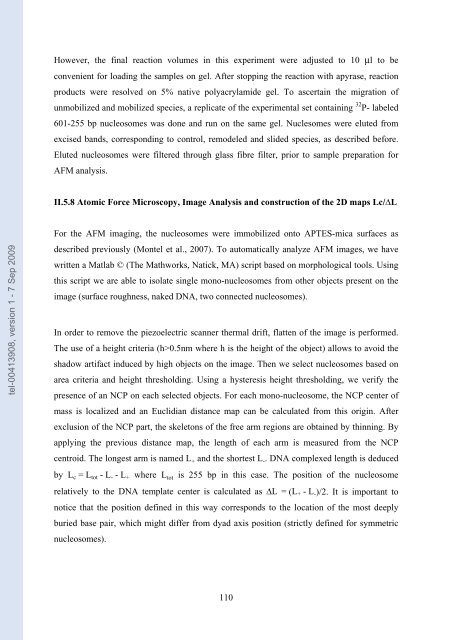Etudes sur le mécanisme de remodelage des nucléosomes par ...
Etudes sur le mécanisme de remodelage des nucléosomes par ...
Etudes sur le mécanisme de remodelage des nucléosomes par ...
You also want an ePaper? Increase the reach of your titles
YUMPU automatically turns print PDFs into web optimized ePapers that Google loves.
tel-00413908, version 1 - 7 Sep 2009<br />
However, the final reaction volumes in this experiment were adjusted to 10 μl to be<br />
convenient for loading the samp<strong>le</strong>s on gel. After stopping the reaction with apyrase, reaction<br />
products were resolved on 5% native polyacrylami<strong>de</strong> gel. To ascertain the migration of<br />
unmobilized and mobilized species, a replicate of the experimental set containing 32 P- labe<strong>le</strong>d<br />
601-255 bp nuc<strong>le</strong>osomes was done and run on the same gel. Nuc<strong>le</strong>somes were eluted from<br />
excised bands, corresponding to control, remo<strong>de</strong><strong>le</strong>d and sli<strong>de</strong>d species, as <strong>de</strong>scribed before.<br />
Eluted nuc<strong>le</strong>osomes were filtered through glass fibre filter, prior to samp<strong>le</strong> pre<strong>par</strong>ation for<br />
AFM analysis.<br />
II.5.8 Atomic Force Microscopy, Image Analysis and construction of the 2D maps Lc/�L<br />
For the AFM imaging, the nuc<strong>le</strong>osomes were immobilized onto APTES-mica <strong>sur</strong>faces as<br />
<strong>de</strong>scribed previously (Montel et al., 2007). To automatically analyze AFM images, we have<br />
written a Matlab © (The Mathworks, Natick, MA) script based on morphological tools. Using<br />
this script we are ab<strong>le</strong> to isolate sing<strong>le</strong> mono-nuc<strong>le</strong>osomes from other objects present on the<br />
image (<strong>sur</strong>face roughness, naked DNA, two connected nuc<strong>le</strong>osomes).<br />
In or<strong>de</strong>r to remove the piezoe<strong>le</strong>ctric scanner thermal drift, flatten of the image is performed.<br />
The use of a height criteria (h>0.5nm where h is the height of the object) allows to avoid the<br />
shadow artifact induced by high objects on the image. Then we se<strong>le</strong>ct nuc<strong>le</strong>osomes based on<br />
area criteria and height thresholding. Using a hysteresis height thresholding, we verify the<br />
presence of an NCP on each se<strong>le</strong>cted objects. For each mono-nuc<strong>le</strong>osome, the NCP center of<br />
mass is localized and an Euclidian distance map can be calculated from this origin. After<br />
exclusion of the NCP <strong>par</strong>t, the ske<strong>le</strong>tons of the free arm regions are obtained by thinning. By<br />
applying the previous distance map, the <strong>le</strong>ngth of each arm is mea<strong>sur</strong>ed from the NCP<br />
centroid. The longest arm is named L + and the shortest L -. DNA comp<strong>le</strong>xed <strong>le</strong>ngth is <strong>de</strong>duced<br />
by Lc = Ltot - L- - L+ where L tot is 255 bp in this case. The position of the nuc<strong>le</strong>osome<br />
relatively to the DNA template center is calculated as ∆L = (L+ - L-)/2. It is important to<br />
notice that the position <strong>de</strong>fined in this way corresponds to the location of the most <strong>de</strong>eply<br />
buried base pair, which might differ from dyad axis position (strictly <strong>de</strong>fined for symmetric<br />
nuc<strong>le</strong>osomes).<br />
110

















